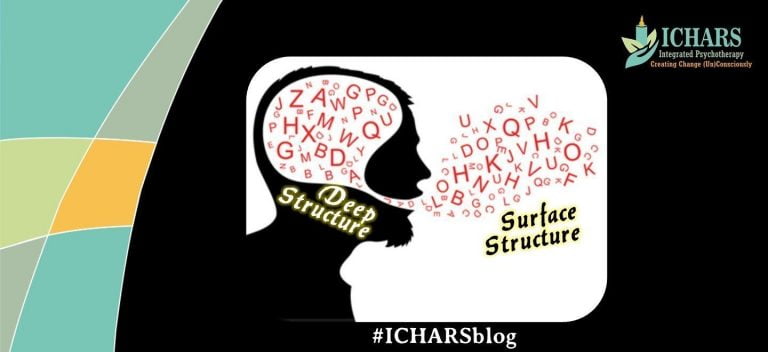In the previous post we looked at the purpose of Meta Model questions during interview process and also got an introduction to deep structure and surface structure of language. In this post let us delve a bit deeper into the deep structure and surface structure to explore the role they play in communication or mis-communication.
Introduction to Deep Structure and Surface Structure

The terms deep structure and surface structure were introduced by Noam Chomsky as a part of his work on transformational grammar. As per Chomsky deep structure refers to concepts, thoughts, ideas & feelings whereas surface structure refers to the words / language we use to represent the deep structure.
Differentiating Deep Structure and Surface Structure
Have you ever experienced a situation where you felt words were not enough to express what you had in mind?
If yes, you already understand what is the difference between deep structure and surface structure. Deep structure is what you wish to express and surface structure how you express it in with the help of words and sentence.

To give you an example, If I were to tell you that “I bought colourful clothes”. This is a surface structure representing a more detailed and elaborate experience (deeper structure). The deep structure will contain a lot more details like:
- How many clothes?
- Which types?
- What colours?
- Which clothes did I discarded while buying the ones I bought?
- Where did I buy them from?
- Who I was with when I bought the clothes?
- What was the overall experience of buying these clothes
- How I felt while buying these clothes?
- What were the factors based on which I bought some clothes and discarded others?
- How much did it cost?
These are just some of the questions. But there will be many more questions that I will need to answer before being able to represent my complete experience, wouldn’t I?
Transformation from Deep Structure to Surface Structure
If you notice, in the process of transforming the deep structure to surface structure, a lot of information has been deleted. This deleted information may not hold much value in a normal day to day conversation but during therapies or in other situations where specific details are important, this deleted information may hold a lot of value.
It is also important to remember that along with deletion, during the process of transformation from deep to surface structure, generalisation and distortion can also take place.
Consider the statement “Everyone hates me”.
The statement contains both generalisation (Everyone – who?) & distortion (Hates me – how exactly do I know?).
These are only some of the examples. We can divide these generalisations, deletions and distortions in subcategories and learn to ask the right questions to move from surface structure back to the deep structure.
Importance of Understanding Deep Structure and Surface Structure
As mentioned during the previous post, when a client narrates a problem, what they are trying to represent through their narration is the part of the map that contains the problem i.e. the deep structure. But they are using the surface structure to represent the same.
Now if a particular deep structure could have been represented by only one surface structure and a particular surface structure could only represent one deep structure there would be no scope for misunderstanding and hence there wouldn’t have been any need to question the surface structure. But alas that is not the case.
Because of the nature of language, a particular deep structure can be represented by multiple surface structure sentences.
“I bought colourful clothes” and “Colourful clothes were bought by me” are two different surface structure sentences that mean exactly the same thing i.e. represent the same deep structure.
Also a particular surface structure sentence can be used to represent multiple deep structures.
“Speaking to you as an intelligent person” is a surface structure that could represent two different deep structures. Does the sentence represent a deep structure where:
- I think of you as an intelligent person? or
- I think of myself as an intelligent person who is speaking to you?
This creates a scope of misunderstanding as the speaker may have used surface structure to represent deep structure 1 but the listener may have understood deep structure 2 because of ambiguity or lack of specific details. Now the decisions and actions of the listener are based on the deep structure 2 instead of the deep structure 1.
Consider the following statement that a client speaks to the therapist while discussing his relationship issues.:
“My spouse’s parents treat my children differently because they are handicapped.”
This surface level structure could represent a deep structure where:
- My children are handicapped
- My spouse’s parents are handicapped
Also the expression “treat my children differently” is a vague expression that could mean different things. It could mean:
- Treat my children favourably or
- It could mean unfavourably.
Also the actual action that is being termed as “different treatment” can represent different deep structures.
Now if the therapist does not ask questions to explore the deep structure, the therapist will have to continue the therapy based on their interpretation of the surface structure. Since there is a possibility of incorrect interpretation, the entire line of therapy could go off-track.
This is one of the primary reason why we recommend that the therapist should not assume anything about the client and avoid reading between the lines as far as possible.
Conclusion
I hope you have been able to understand the difference between the surface structure and deep structure and the need to question the surface structure sentence to be able to understand the deep structure as far as possible. Meta model is a very powerful questioning tool to achieve this outcome.
Meta Model as a topic is covered extensively in the level 2 of our Advanced Coaching Certification Program and the Advanced Psychotherapy Certification Program.
In case you are not planning to join the certification program for now, you can enroll for the online module on effective questioning skills and develop a deeper understanding about the NLP Meta Model questions.

